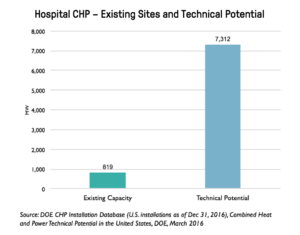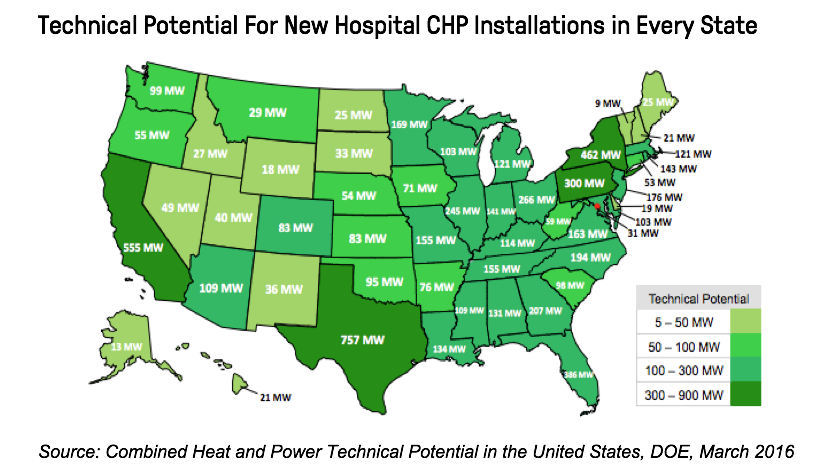By Jared Solomon, intern, in collaboration with Jennifer Kefer, Vice President of David Gardiner and Associates and Executive Director of the Alliance for Industrial Efficiency
2017 saw a record-breaking number of storm events, slamming the East Coast and causing major disruptions to the power grid. Such disruptions are especially dangerous for hospitals, which rely on a constant supply of energy to keep many of their patients alive. As we anticipate similar threats in the future, it is clear that hospitals, along with other energy-dependent industries and services, must adapt.
One especially promising form of energy independence that would increase resilience lies in combined heat and power technology (CHP), which works by generating both heat and electricity on site from the same fuel source. Through this process, generating plants can sometimes double their efficiency, often reaching levels of over 80% efficiency – compared to only around 50% for separate electricity and thermal energy processes and an average of 36% for overall conventional power generation. As a result, buildings that utilize CHP use significantly less energy than their counterparts. This allows these buildings to both significantly reduce operating costs and achieve new levels of independence from the grid, becoming markedly less at-risk to disruptive events like major storms.
Hospitals’ coincident power and thermal loads are key to their CHP potential. Hospitals can use heat produced as a byproduct from on-site energy generation for hot water or building heating rather than allowing it to escape unused into the atmosphere. Hospitals already have particularly high energy demands, consuming over twice as much energy per square foot as the average commercial building. As a result, they can slash their energy use and expenses by meeting their space heating, cooling, and hot water needs through CHP.
Not only can hospitals benefit substantially from CHP systems, but they also represent an area of largely untapped potential. A 2016 DOE report determined that the healthcare industry has the technical potential to expand CHP usage by almost 1000% — increasing from 819 MW (existing capacity) to 8,131 MW.
Yet perhaps more important than the overall potential is where this potential is located. Out of that 7,312 MW of potential new CHP capacity, 3,701 MW – almost half – is located in states that border the Atlantic Ocean and are therefore especially susceptible to major hurricane events. There are 757 MW of potential CHP installations in hospitals in Texas alone – where infrastructure is still recovering from Hurricane Harvey. These hospitals are therefore especially well-positioned to benefit from the addition of CHP technology to their systems.
CHP has already proved its lifesaving abilities in hospitals many times over. A 2012 installation of a 48 MW CHP system at the Texas Medical Center in Houston allowed the hospital to retain power during Hurricane Harvey in August 2017. As the largest medical center in the world, the results of a total power outage there could have been catastrophic. Instead, the hospital was able to continue to operate the largest chilled water district energy system in the United States, as well as meet crucial air conditioning, refrigeration, heating, sterilization, and laundry needs.
When Hurricane Sandy struck the Mid-Atlantic in 2012, Long Island’s South Oak Hospital was able to operate independently of the grid for 15 days. Similar success stories played out across the Mid-Atlantic – at Danbury and Greenwich Hospitals in Connecticut, the Christian Health Care Center in New Jersey, and the Nassau University Medical Center in New York. Each of these institutions was able to retain critical systems throughout the blackouts due to their CHP systems, with many of the hospitals also taking in extra patients from surrounding hospitals that were unable to continue to function during the storm.
In stark contrast, hospitals without CHP systems have been entirely crippled during weather events. While South Oak Hospital functioned normally during Hurricane Sandy, the nearby NYU Langone Medical Center lost power and was forced to evacuate 215 patients to nearby facilities. Following the incident, Langone announced a plan to construct new energy infrastructure, complete with an 11 MW CHP system for self-sufficiency in case of future weather events.
CHP hosts are also more financially resilient because these systems insulate hosts from fluctuating energy prices. While installations require a substantial up-front investment, in some areas, these systems can pay for themselves in less than five years. For example, Partners Healthcare in Massachusetts installed CHP systems in five hospitals following Hurricane Katrina and due to fluctuations in energy prices leading to high energy bills. Through energy savings from the new systems as well as utility rebates, Partners recovered the initial cost in 18 months. Meanwhile, CHP systems can successfully function for decades, significantly reducing energy costs throughout the project life.
CHP is more reliable than backup generators, making it the best option for local energy production during blackout events – especially in the context of hospitals. This reliability increase is due to a few reasons. First, backup generators are generally only used when needed, while CHP systems are consistently active and therefore much better maintained. Backup generators also often rely on a finite supply of fuel, while CHP systems often are linked to underground natural gas infrastructure rarely affected by weather events. Finally, backup generators often require lag time to start up after power outages; any lag between a loss of power and generator startup can have profoundly negative impacts on hospitals that require constant energy to keep patients alive. CHP, as a primary local energy source, is constantly running and therefore avoids any possibility of a blackout period.
With the increase in extreme weather events, hospitals must become more resilient. Combined heat and power provides this self-sufficiency, allowing hospitals to both significantly reduce energy costs over time and continue to function during extreme weather events and other natural and manmade grid disruptions.
Read more about the opportunity for CHP in natural disaster mitigation in a new fact sheet from the Alliance.
If you’re interested learning more about the opportunity for CHP in hospitals, check out this webinar from GE on Improving Hospitals Resiliency and Operations with Flexible Onsite Power.
